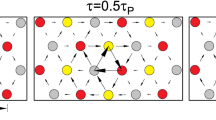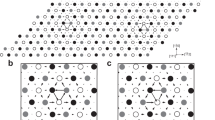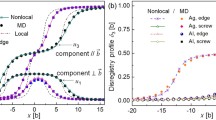Abstract
A comparison between the dipole and cluster approaches for the study of the core structure and Peierls potential of 1/2 \(\langle 111\rangle\) screw dislocations in bcc metals is presented. It is based on first principles electronic structure calculations in alpha iron carried out within the DFT framework using localized basis functions as implemented in the SIESTA code. The effect of the energetic model is first investigated on the {211} and {110} generalized stacking fault energy (γ) surfaces which are known to be closely related to the dislocation core properties. All DFT results yield similar shapes—characteristic of a non-degenerate core structure—and the effect of the exchange-correlation functional is shown to be larger than the discrepancies between SIESTA and planewave-pseudopotential results. The core structure is found to be non-degenerate, with an excellent agreement between the various approaches on the deviation from the linear elasticity theory of the atomic positions. In the dipole approach, the interaction between dislocations is dominated by elastic effects, but significant anisotropic core–core interactions are evidenced, which strongly affect the energetics of the system when a triangular array of dipoles is used. For the calculation of the Peierls potential a very good agreement is obtained between the cluster approach and the dipole approach, provided that a quadrupolar-like arrangement is used. Similar calculations are performed with the EAM potential proposed by Mendelev et al. [Philos. Mag. 83, 3977 (2003)] for iron; the comparison between the two sets of results is briefly discussed.
Similar content being viewed by others
References
Vitek, V.: Theory of the core structures of dislocations in body-centred-cubic metals. Cryst. Latt. Def. 5, 1–34 (1974)
Duesbery, M.S., Vitek, V.: Plastic anisotropy in bcc transition metals. Acta Mater. 46, 1481–1492 (1998)
Marian, J., Cai, W., Bulatov, V.V.: Dynamic transitions from smooth to rough to twinning in dislocation motion. Nat. Mater. 3, 158–163 (2004)
Chaussidon, J., Fivel, M., Rodney, D.: The glide of screw dislocations in bcc Fe: atomistic static and dynamic simulations. Acta Mater. 54, 3407–3416 (2006)
Frederiksen, S.L., Jacobsen, K.W.: Density functional theory studies of screw dislocation core structures in bcc metals. Philos. Mag. 83, 365–375 (2003)
Domain, C., Monnet, G.: Simulation of screw dislocation motion in iron by molecular dynamics simulations. Phys. Rev. Lett. 95, 215506 (2005)
Segall, D.E., Strachan, A., Goddard, W.A. III., Ismail-Beigi, S., Arias, T.A.: Ab initio and finite-temperature molecular dynamics studies of lattice resistance in tantalum. Phys. Rev. B 68, 014104 (2003)
Woodward, C., Rao, S.I.: Flexible boundary conditions: simulating isolated dislocations in bcc Mo and Ta. Phys. Rev. Lett. 88, 216402 (2002)
Cai, W., Bulatov, V.V., Chang, J., Li, J., Yip, S.: Periodic image effects in dislocation modeling. Philos. Mag. 83, 539–567 (2003)
Mendelev, M.I., Han, S., Srolovitz, D.J., Ackland, G., Sun, D.Y., Asta, M.: Development of new interatomic potentials appropriate for crystalline and liquid iron. Philos. Mag. 83, 3977–3994 (2003)
Dudarev, S.L., Derlet, P.M.: A magnetic interatomic potential for molecular dynamics simulations. J. Phys.: Condens. Matter 17, 7097–7118 (2005)
Soler, J.M., Artacho, E., Gale, J.D., García, A., Junquera, J., Ordejón, P., Sánchez-Portal, D.: The SIESTA method for ab initio order-N materials simulation. J. Phys.: Condens. Matter. 14, 2745–2779 (2002)
Fu, C.-C., Willaime, F., Ordejón, P.: Stability and mobility of mono- and di-interstitials in α-Fe. Phys. Rev. Lett. 92, 175503 (2004)
Li, J., Wang, C.-Z., Chang, J.-P., Cai, W., Bulatov, V.V., Ho, K.-M., Yip, S.: Core energy and Peierls stress of a screw dislocation in bcc molybdenum: a periodic-cell tight-binding study. Phys. Rev. B 70, 104113 (2004)
Cai, W.: Modeling dislocations using a periodic cell. In: S. Yip (ed.) Handbook of Materials Modeling, p. 813. Springer (2005)
Yan, J.-A., Wang, C.-Y., Wang, S.-Y.: Generalized-stacking-fault energy and dislocation properties in bcc Fe: A first-principles study. Phys. Rev. B 70, 174105 (2004)
Author information
Authors and Affiliations
Corresponding author
Rights and permissions
About this article
Cite this article
Ventelon, L., Willaime, F. Core structure and Peierls potential of screw dislocations in α-Fe from first principles: cluster versus dipole approaches. J Computer-Aided Mater Des 14 (Suppl 1), 85–94 (2007). https://doi.org/10.1007/s10820-007-9064-y
Published:
Issue Date:
DOI: https://doi.org/10.1007/s10820-007-9064-y




